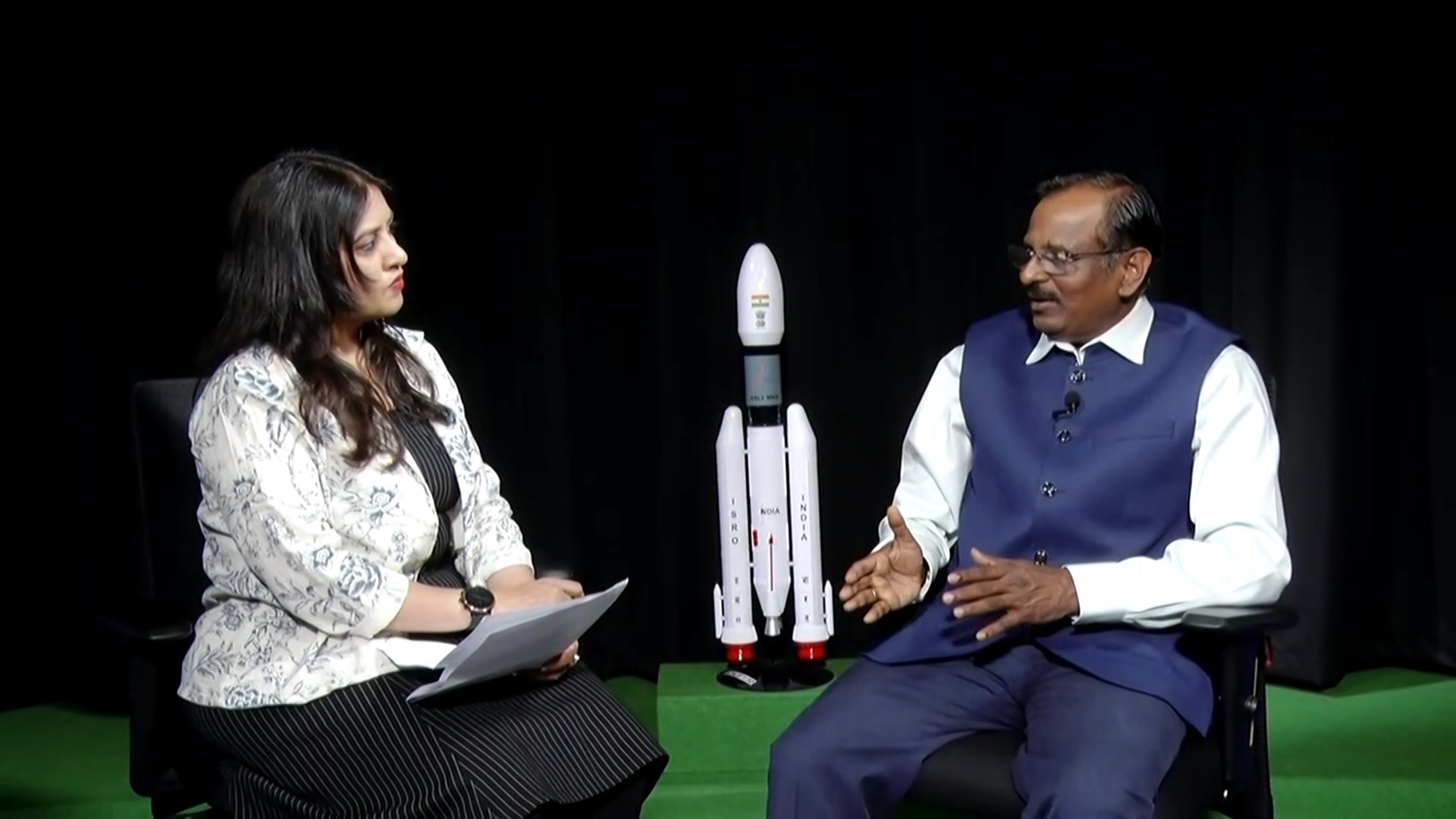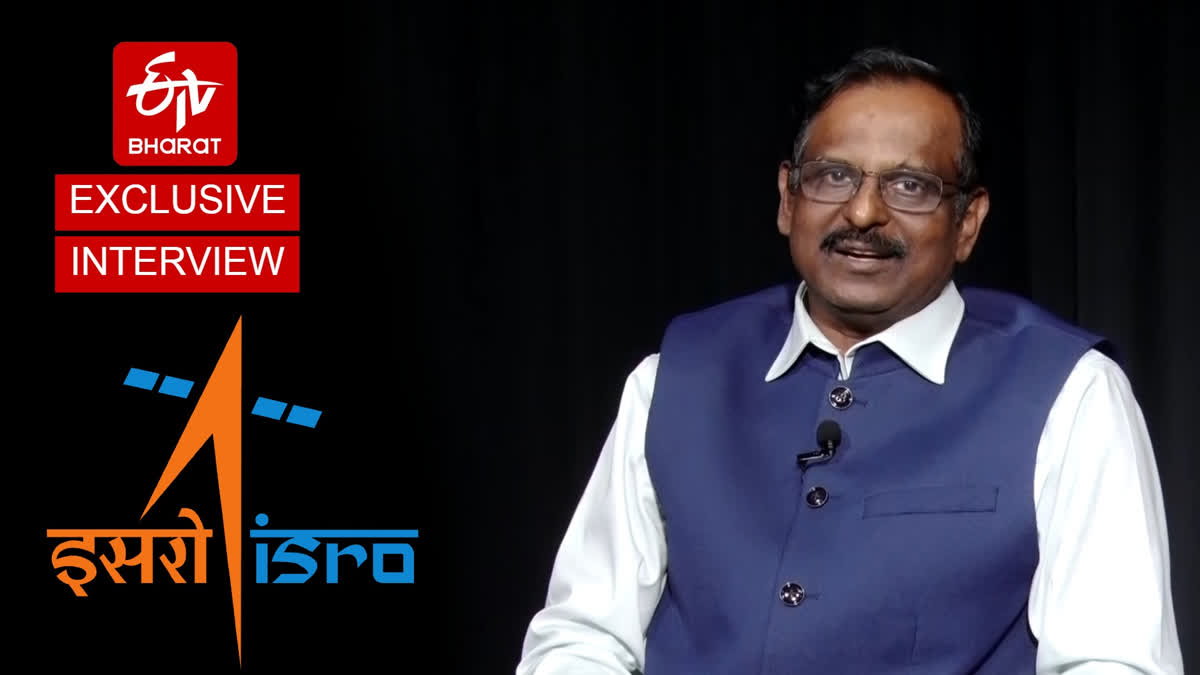Bengaluru: The newly appointed ISRO Chairman, Secretary of the Department of Space, rocket scientist, and aerospace engineer--V Narayanan--talked candidly about a range of issues with ETV Bharat representative Anubha Jain at ISRO Headquarters in Bengaluru on Thursday.
Having accomplished missions like the recent Space Docking to the historic Chandrayaan-3 moon mission, the space agency plans to achieve many other such ambitious missions in the future. Gaganyaan and Chandrayaan-4 are lined up in ISRO's basket for 2026 and 2027, respectively, with missions to Venus and Mars also existing on the roadmap. Narayanan presented an insightful perspective on the dynamics of space, India’s space agency ISRO’s ongoing mission, vision for 2025, and what lies ahead for the future. He talked about strategic goals that will continue to elevate India's presence in the global space community.
Following is an excerpt of the interview:
Anubha Jain: What advancements can we expect in ISRO's launch vehicle technology, particularly with the development of Next Generation Launch Vehicles (NGLV)?
V Narayanan: ISRO has made significant strides in launch vehicle development since the introduction of the SLV 3 in 1979, which was capable of carrying a 40 kg payload to Low Earth Orbit (LEO). Over the years, six generations of launch vehicles have been developed, including SLV 3, ASLV, PSLV, GSLV Mk II, GSLV Mk III, and SSLV. With ISRO recently achieving its 100th launch milestone, the payload capacity has grown substantially, with the current capability reaching 8,500 kg to LEO.
The next-generation launch vehicle under development will have a staggering 30,000 kg payload capacity to LEO, marking a 1,000-fold increase from the SLV 3. This 1,000-tonne lift-off mass vehicle will stand 93 meters tall and feature three stages, supported by two solid strap-on boosters, each with 190 tonnes of propellant. The first stage will be powered by nine engines, each producing 110 tonnes of thrust with a propellant load of 475 tonnes. The second stage will feature two engines, while the upper C32 cryogenic stage will use a liquid oxygen and liquid hydrogen propellant combination.
This next-generation launch vehicle represents a major leap in ISRO's space exploration capabilities. Unlike previous expendable launch vehicles, which were designed for a single use, the new vehicle introduces a groundbreaking feature-- the recovery and reuse in the first stage. This innovation marks a significant leap in reusability, enhancing cost-efficiency and sustainability in space operations. The first stage will be recovered after launch, setting the stage for future advancements in reusable space technology.
Watch the full interview here:
Anubha Jain: ISRO has quite ambitious plans for the future, including Gaganyaan in 2026 and Chandrayaan-4 in 2027. These projects are pushing India to new frontiers in space exploration, involving human spaceflight and interplanetary research. Where does the space agency stand in terms of preparations, and what are the current challenges regarding these two missions?
V Narayanan: The Gaganyaan mission, which aims to send three astronauts to a 400 km Low Earth Orbit (LEO), will utilise a human-rated LVM 3 vehicle (HLVM 3). This vehicle will be equipped with enhanced structural and thermal margins, as well as increased redundancy to improve reliability. Key developments include a real-time vehicle health monitoring system, an orbital module system for crew safety, and an advanced environmental control and safety system.
The vehicle will transport the astronauts to 170 km, then to 400 km, maintaining orbit, before safely returning them to Earth. The service module’s propulsion system will manage both the ascent and descent, with velocity reduction during re-entry, followed by parachute-assisted landing. These parachutes are developed with DRDO support in Agra.
Before the crewed mission, three uncrewed test flights will take place, with first one scheduled for this year from Sriharikota. After successful testing, the crewed mission will follow. Additionally, astronauts will undergo rigorous physical and training modules to ensure mission readiness.
- Also read: Gaganyaan Is Immediate Priority: ISRO Chairman V Narayanan Discusses Human Spaceflight Mission
[Coming to ISRO's moon mission], while Chandrayaan-3 achieved a soft landing and provided valuable data on surface minerals, thermal gradients, electron clouds, and seismic activity, Chandrayaan-4 marks a quantum leap. It will not only land softly on the Moon's south pole but also collect samples and conduct further experiments.
He further said that Chandrayaan 4 will be a 9,200 kg satellite, a significant increase from the 4,000 kg Chandrayaan 3. Due to its size, it will be launched in two Mark III rockets, assembled in five modules with two stacks. These modules will dock in Earth's orbit, where the propulsion system will be separated. Four modules will travel to the Moon's orbit, with two eventually landing on the surface. The sample return module will only return to Earth, docking with the other two modules in lunar orbit.
Anubha Jain: What steps are being taken to ensure the success and safety of human spaceflight under the Gaganyaan mission, particularly during spacecraft reentry?
V Narayanan: When an object with high velocity re-enters the Earth's atmosphere, it generates significant heat. To address this, ISRO is developing and demonstrating advanced thermal protection systems to ensure safe re-entry. In the final phase, the spacecraft will be slowed to a precise, controlled velocity using parachutes, ensuring a safe and accurate landing.
Anubha Jain: ISRO completed the SpaDEX mission, achieving a crucial docking milestone. While the mission appeared challenging from the outset, we're curious about ISRO's perspective on its complexity. Additionally, how will the newfound docking capabilities influence the space agency's future missions and objectives?
V Narayanan: On January 16th, 2025, India became the fourth country to successfully carry out a satellite docking process in Low Earth Orbit (LEO). In a very complex procedure, two 20 kg satellites, initially separated with a distance of 11 to 12 km, docked after precise control and measurement. This docking and undocking process is ongoing, with the two satellites now rotating as a unified system. Power transfer between the satellites will soon begin, and after multiple docking cycles, valuable data will be collected for further analysis.
Starting in March 2025, a series of experiments will be conducted to refine the process. In addition, approval has been granted for the development of a five-module space station, with the first module slated for launch in 2028.
Anubha Jain: ISRO is opening doors to private space companies with a focus on satellite manufacturing, launch services, and space tech. How do you plan to involve the private sector in ISRO's projects and missions?
V Narayanan: India currently has 131 satellites in orbit, with 56 actively serving the nation. The growing demand for telecommunication, navigation, real-time tracking of trains and ships, border monitoring, and agricultural applications has highlighted the need for more satellite infrastructure. Due to limited manpower at ISRO, private companies have been engaged to build satellites and launch vehicles. ISRO supports these private players by providing technical expertise, facilitating experiments, and offering access to its facilities for satellite launches, fostering innovation and collaboration in the space sector.
Anubha Jain: Can you share your vision for ISRO's role in enhancing India's navigation capabilities with the NavIC system?
V Narayanan: Phase I of the navigation system has successfully deployed a couple of satellites, marking the beginning of a strategic effort by ISRO. In Phase II, five more satellites will be launched, with the 100th launch placing two satellites into orbit. The National Space-Based Positioning, Navigation, and Timing (PNT) service, spearheaded by ISRO, is set to enhance both strategic and civilian applications, including aerospace, aircraft landing systems, and resource identification. With rigorous planning and execution, ISRO aims to complete the deployment of satellites within the next two years, significantly advancing global navigation capabilities.

Anubha Jain: How will ISRO continue to contribute to international space collaborations, such as the NISAR mission with NASA?
V Narayanan: The NISAR satellite, a joint collaboration between ISRO and NASA, is designed to provide critical data for global monitoring. It will map the entire Earth every 12 days, offering consistent spatial and temporal insights into ecosystems, ice mass, vegetation biomass, sea level rise, groundwater, and natural hazards like earthquakes, tsunamis, volcanoes, and landslides. NISAR carries two key payloads-- the S-band synthetic aperture radar (developed by ISRO) and the L-band radar (developed by NASA). The satellite is built with contributions from both agencies, with ISRO responsible for the structure, power, and propulsion systems.
Anubha Jain: How is ISRO preparing to address the growing challenges of space debris? Can you elaborate on ISRO's plans for ensuring the long-term sustainability of space activities, including debris monitoring, collision avoidance, and end-of-life disposal of satellites?
V Narayanan: It is an important domain. There was a time when space was free with a smaller number of satellites. Nowadays, every country has its satellites. As these satellites reach the end of their operational lives, they contribute to the growing issue of space debris. Although small in size, space debris moves at extremely high velocities and can cause significant damage to other satellites or rockets if they collide. To address this, the Space Situational Awareness (SSA) program monitors debris in real-time during satellite launches to assess potential risks. Additionally, strategies are being developed to manage and remove debris, such as repositioning satellites to alternative orbits or refuelling them for continued use, rather than allowing them to become hazardous debris.
Anubha Jain: Apart from Chandrayaan-4 and Gaganyaan, can you discuss any upcoming scientific missions that ISRO is particularly excited about?
V Narayanan: ISRO has received approval for several missions, including the Venus mission and the Mars Orbiter Mission. However, a key focus is the Lunar Polar Exploration Mission (LUPEX), a significant enhancement of the Chandrayaan-3 mission. The LUPEX mission will feature a rover weighing 250 kg, a substantial increase compared to the 25 kg rover from Chandrayaan-3. This ambitious project is being developed in collaboration with the Japanese Aerospace Exploration Agency (JAXA), marking a crucial step in advancing lunar exploration and scientific discovery.
Anubha Jain: Could you share your vision for ISRO's future solar missions, and how they will build on the success of Aditya-L1?
V Narayanan: On January 6th of this year, ISRO released the preliminary data from the Aditya-L1 mission. This data provides valuable insights into the Sun's behaviour and will serve as the foundation for further research across various scientific domains. By analysing this data, researchers can deepen their understanding of solar phenomena and its impacts on space weather, paving the way for advancements in space science and related fields.
Anubha Jain: What are the key milestones ISRO aims to achieve in the next decade?
V Narayanan: ISRO's immediate priority is the Gaganyaan program, followed by enhancing low-cost access to space. The Mark III vehicle, with a capacity of 4,000 kg to geo transfer orbit, will be upgraded with a new propulsion system to increase its capacity by 25 per cent, all while reducing launch costs. ISRO is also working on liquid oxygen and a 200-tonne thrust engine. The next-generation launcher aims to be 1,000 times more capable than the SLV III.
Upcoming scientific missions include the Venus mission, Mars Orbiter Mission, Chandrayaan-4, and Chandrayaan-5. ISRO is also focusing on satellites for communication, navigation, disaster mitigation, and resource monitoring. Building a space station for experiments and a gateway for interplanetary exploration, including landing Indians on the Moon, is a key goal.
- Also read: Two Rockets, Five Modules, One Lunar Dream - ISRO Chairman V Narayanan Talks Chandrayaan-4
From being 70 years behind when India began its space program, ISRO has made remarkable progress and is now a leader in space exploration. With growing payload capacity, ISRO aims to contribute to India's vision of becoming a developed nation before celebrating 100 years of independence.
Anubha Jain: Does ISRO have any missions planned to discover and study exoplanets, specifically focusing on the possibility of life on them?
V Narayanan: Yes, debates and discussions are ongoing for doing a couple of experiments in that direction.
Anubha Jain: What are some of the biggest personal challenges you've faced in your journey to becoming ISRO's Chief, and how did you overcome them?
V Narayanan: Coming from a humble background, I studied in a Tamil-medium government school and completed engineering as a first-rank holder. After securing a campus placement, I worked for over a year in the private sector at BHEL before joining ISRO. Over 41 years at ISRO, including seven years as the Director of the Liquid Propulsion Systems Centre, I contributed significantly to the field. I pursued my Master's and PhD in cryogenic propulsion and made notable advancements in the domain.
Anubha Jain: How do you envision the future of space exploration and India's role in it on a personal level?
V Narayanan: Today ISRO has achieved great stature. ISRO is serving the country in a big way and common man in multiple areas. In 1962 India wasn’t financially strong. Visionary leaders like Vikram Sarabhai recognised that advanced space technology could greatly benefit the masses. Over the years, ISRO has not only achieved self-sufficiency but has also positioned itself as a global leader in space technology.
Today, ISRO's optical payloads, such as those in the Chandrayaan-2 mission, are among the best in the world. The high-resolution orbital camera on Chandrayaan-2 stands as a testament to ISRO's expertise and commitment to excellence. The organisation’s goal has always been to serve the common people of India, and its achievements in space exploration reflect this mission.
Looking ahead, ISRO’s human spaceflight program and space station are poised to become a reality in the next 25 years, with ISRO continuing to take on leadership roles and lay the foundation for future advancements.
Also read: Inside ISRO's NGLV Plans: V Narayanan Shares Insights Into 30-Tonne Payload Vehicle



